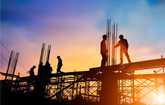NEW YORK, Aug. 29, 2016 /PRNewswire/ -- Synopsis
Iran's construction industry is set to perform well over the forecast period (2016–2020), with growth driven by investments in infrastructure, energy and residential construction projects. Improvements in investor and consumer confidence due to the lifting of international sanctions will also drive funds into construction projects.
The industry's output value in real terms is expected to rise at a compound annual growth rate (CAGR) of 6.34% over the forecast period, up from -1.64% during the review period (2011–2015).
There are certain risks associated with Iran's construction industry outlook, most notably low oil prices, high labor costs, corruption and political risk. Falling oil prices are expected to affect government earnings from oil export.
Summary
Timetric's Construction in Iran – Key Trends and Opportunities to 2020 report provides detailed market analysis, information and insights into the Iranian construction industry including:
- The Iranian construction industry's growth prospects by market, project type and construction activity
- Analysis of equipment, material and service costs for each project type in Iran
- Critical insight into the impact of industry trends and issues, and the risks and opportunities they present to participants in the Iranian construction industry
- Profiles of the leading operators in the Iranian construction industry
- Data highlights of the largest construction projects in Iran
Scope
This report provides a comprehensive analysis of the construction industry in Iran. It provides:
- Historical (2011-2015) and forecast (2016-2020) valuations of the construction industry in Iran using construction output and value-add methods
- Segmentation by sector (commercial, industrial, infrastructure, energy and utilities, institutional and residential) and by project type
- Breakdown of values within each project type, by type of activity (new construction, repair and maintenance, refurbishment and demolition) and by type of cost (materials, equipment and services)
- Analysis of key construction industry issues, including regulation, cost management, funding and pricing
- Detailed profiles of the leading construction companies in Iran
Reasons To Buy
- Identify and evaluate market opportunities using Timetric's standardized valuation and forecasting methodologies.
- Assess market growth potential at a micro-level with over 600 time-series data forecasts.
- Understand the latest industry and market trends.
- Formulate and validate strategy using Timetric's critical and actionable insight.
- Assess business risks, including cost, regulatory and competitive pressures.
- Evaluate competitive risk and success factors.
Key Highlights
- According to the Central Bank of Iran (CBI), the total number of construction permits issued in urban areas declined by 32.1%; from 172,600 permits in FY2013–2014 to 117,300 permits in FY2014–2015. Moreover, the total floor area of permits issued in urban areas declined by 40.2%; from 120.6 million m2 in FY2013–2014 to 72.1 million m2 in FY2014–2015. The imposition of international sanctions and a decline in oil prices, which was the country's main economic driver, affected the country's economy and construction industry, which led to the halving of foreign investments and oil export revenues. However, with the lifting of international sanctions, the Iranian construction industry is recovering.
- Iran faces a housing shortage due to its population growth and urbanization. Despite the construction of a large number of housing units, supply is relatively low when compared to demand. According to the Ministry of Housing and Urban Development, 1.5 million new housing units are required annually, but only 700,000 units are constructed. To maintain a balance between supply and demand, 4.0 million new units are required to be built to address the shortage. Iran's housing deficit and growing urban population will continue to generate demand for residential construction over the forecast period, and provide lucrative opportunities for residential housing developers.
- With robust and modern infrastructure vital to economic growth and competitiveness, the government is focusing on infrastructure development. Accordingly, to improve the country's rail network and align the regional rail network in the subcontinent to Central Asia and the Persian Gulf, in 2015 the government announced its plans to develop the country's rail network by 2025. As a result, the country's total rail network is expected to increase from 15,000km in 2015 to 25,000km in 2025.
- To enhance the country's transport infrastructure, the government is seeking help from foreign investors. Accordingly, in January 2016, a memorandum of understanding for cooperation in the rail sector was signed between the Islamic Republic of Iran Railways (RAI) and Siemens, a German company, to develop the country's rail infrastructure and boost the economy.
- The government is focusing on renewable energy sources to reduce the country's dependence on hydrocarbons, improve energy security and meet rising energy demand. Accordingly, under the sixth five-year Economic Development Plan (2016–2021), the government aims to increase renewable energy capacity to 5GW by 2018.
Read the full report: http://www.reportlinker.com/p04049469-summary/view-report.html
About Reportlinker
ReportLinker is an award-winning market research solution. Reportlinker finds and organizes the latest industry data so you get all the market research you need - instantly, in one place.
http://www.reportlinker.com
__________________________
Contact Clare: [email protected]
US: (339)-368-6001
Intl: +1 339-368-6001
SOURCE Reportlinker
Related Links
WANT YOUR COMPANY'S NEWS FEATURED ON PRNEWSWIRE.COM?
Newsrooms &
Influencers
Digital Media
Outlets
Journalists
Opted In



Share this article